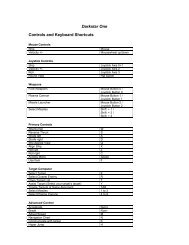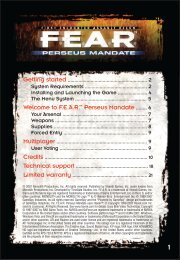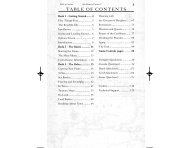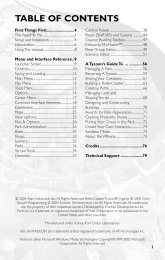Heads-Up Display Modes 35 - Metaboli
Heads-Up Display Modes 35 - Metaboli
Heads-Up Display Modes 35 - Metaboli
You also want an ePaper? Increase the reach of your titles
YUMPU automatically turns print PDFs into web optimized ePapers that Google loves.
<strong>Heads</strong>-<strong>Up</strong> <strong>Display</strong> <strong>Modes</strong> 57<br />
The HUD will also display the GH Shoot Cue or OTB Reject Cue (pronounced “ote-ve,”<br />
stands for “Turn Away” in Russian). In English, the Shoot Cue designator is<br />
LA for “Launch Authorized,” and the Reject Cue designator is No LA for “No<br />
Launch Authorized.” The Shoot Cue informs you that the selected missile is ready<br />
for launching and the target is within the missile’s reliable launch parameters. Fire<br />
the missile by pulling the trigger (Space Bar). The Reject Cue warns that you are<br />
too close to the target and prohibits launch. If you lock onto friendly aircraft, the<br />
IFF will detonate CDJQ, meaning“Ours”.<br />
If the radar or the EOS switches to autotracking from Helmet mode, cross-hairs<br />
superimpose on the Targeting Circle (see the figure below). When the HUD gets<br />
the Shoot Cue, the Targeting Circle flashes at a frequency of 2 Hz. If the onboard<br />
computer does not get target range information, the Targeting Circle flashes with<br />
a frequency of 1 Hz (this is common when using the EOS).<br />
10 Km Range Scale<br />
Range to Target<br />
Autotrack Mode Active<br />
Helmet Mounted Targeting<br />
Site<br />
Target’s Heading<br />
Target Designator Circle<br />
(Remains inside HUD field<br />
of view at all times)<br />
Autotrack Submode<br />
4-17: Autotrack Symbology with Helmet-Mounted Sight<br />
When tracking a target in Attack mode, maneuver your aircraft so that the Aiming<br />
Reticle stays close to the HUD centre datum. This eases your workload when the<br />
target is not very visible and prevents the target from breaking the lock.<br />
Remember, if you use the EOS, the flashing of the Shoot Cue with a frequency of<br />
1 Hz warns you that the system is not measuring the range to the target.<br />
Keep in mind that for SARH missiles, it is necessary to illuminate the target for<br />
the entire flight time of the missile. After launch this will be represented by the A<br />
(Autotrack) Cue flashing at 1 MHz. So know your missiles!<br />
If the target leaves the tracking area, or you break the lock by pressing the Tab key,<br />
or the target is destroyed, the radar (the EOS) returns to the submode that<br />
preceded the Autotrack. Similarly, if the radar or EOS is damaged or you switch<br />
sensors off, the lock breaks and the radar returns to the submode that preceded<br />
the Autotrack.<br />
LD< – LHKJ (AWACS) AWACS Datalink<br />
The Flanker’s ability to datalink with AWACS aircraft allows pilots to locate and<br />
stalk targets without ever engaging onboard sensors. This form of “stealth” lets<br />
the Flanker close on its prey without betraying its presence. A friendly AWACS<br />
aircraft (an A-50 or E-3) must be airborne simultaneously to your aircraft. The<br />
datalink information can be viewed on the MFD in all combat modes as well as<br />
the NAV modes; however, these contacts can only be selected for targeting from<br />
the BVR mode. While in BVR mode, if there is a friendly AWACS aircraft airborne,<br />
a datalink will be established, and contacts detected by the AWACS will appear on<br />
the MFD as standard aircraft symbols (friendly and enemy). The AWACS contacts<br />
will appear more subdued (less bright) than regular contacts. Turn on radar at least<br />
once to establish data link.















